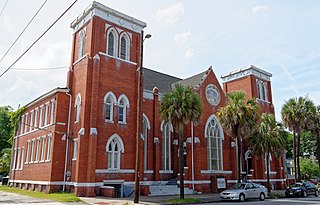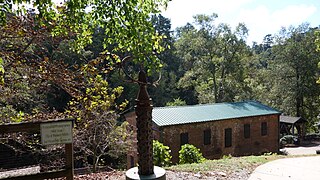
Washington is the county seat of Wilkes County, Georgia, United States. Under its original name, Heard's Fort, it was for a brief time during the American Revolutionary War the Georgia state capital. It is noteworthy as the place where the Confederacy voted to dissolve itself, effectively ending the American Civil War.

The Martin Luther King Jr. National Historical Park covers about 35 acres (0.14 km2) and includes several sites in Atlanta, Georgia related to the life and work of civil rights leader Martin Luther King Jr. Within the park is his boyhood home, and Ebenezer Baptist Church — the church where King was baptized and both he and his father, Martin Luther King Sr., were pastors — as well as, the grave site of King, Jr., and his wife, civil rights activist Coretta Scott King.

The Sweet Auburn Historic District is a historic African-American neighborhood along and surrounding Auburn Avenue, east of downtown Atlanta, Georgia, United States. The name Sweet Auburn was coined by John Wesley Dobbs, referring to the "richest Negro street in the world," one of the largest concentrations of African-American businesses in the United States.

The Georgia Trust for Historic Preservation is the United States' largest statewide, nonprofit preservation organization with more than 8,000 members. Founded in 1973 by Mary Gregory Jewett and others, the Trust is committed to preserving and enhancing Georgia's communities and their diverse historic resources for the education and enjoyment of all.

America's 11 Most Endangered Places or America's 11 Most Endangered Historic Places is a list of places in the United States that the National Trust for Historic Preservation considers the most endangered. It aims to inspire Americans to preserve examples of architectural and cultural heritage that could be "relegated to the dustbins of history" without intervention.

The Candler Building is a 17-story high-rise at 127 Peachtree Street, NE, in Atlanta, Georgia. When completed in 1906 by Coca-Cola magnate Asa Griggs Candler, it was the tallest building in the city. This location where Houston joins Peachtree Street was the location of one of the earliest churches in the city which was built on land donated by Judge Reuben Cone in the 1840s. It forms the northern border of Woodruff Park.

Shiloh Baptist Church is a historic former school building and former African American Baptist church in Newport, Rhode Island.

The Callaway Plantation, also known as the Arnold-Callaway Plantation, is a set of historical buildings, and an open-air museum located in Washington, Georgia. The site was formerly a working cotton plantation with enslaved African Americans. The site was owned by the Callaway family between 1785 until 1977; however, the family still owns a considerable amount of acreage surrounding the Callaway Plantation. When The plantation was active, it was large in size and owned several hundred slaves.

The Medical Arts Building is a Beaux-Arts style building located at the northern end of Downtown Atlanta. The 12-story brick and limestone building by architect G. Lloyd Preacher, also designer of Atlanta City Hall, was constructed in 1927. In addition to its medical facilities - deemed as some of the most modern and well-equipped when it opened, the building once featured a cafeteria, drugstore and telegraph office. It was also amongst the first to have a covered parking garage. However, its nearly 89,000 square feet (8,300 m2) of space have been vacant since 1995.

Hog Hammock is an African-American community on Sapelo Island, a barrier island of the U.S. state of Georgia.

Haralson Bleckley was an American architect who designed many buildings in his hometown of Atlanta, Georgia. Several of his works are listed on the National Register of Historic Places (NRHP). His office was in the Flatiron Building. He also proposed the Bleckley Plaza Plan, a largescale architectural project that would have seen the creation of a large plaza in downtown Atlanta.

Asbury United Methodist Church is a United Methodist church in the Savannah Victorian Historic District in Savannah, Georgia. The church was founded in 1871 and moved to its current location in 1927.

The Roswell Historic District, in Roswell, Georgia in Fulton County, was listed on the National Register of Historic Places in 1974.
The African American Cultural Heritage Action Fund is a program formed in 2017 to aid stewards of Black cultural sites throughout the nation in preserving both physical landmarks, their material collections and associated narratives. It was organized under the auspices of the National Trust for Historic Preservation. The initiative which awards grants to select applicants and advocates of Black history has been led by architectural historian Brent Leggs since 2019. It is the largest program in America to preserve places associated with Black history.

Passtown Elementary School is a historic American school building in Valley Township, Chester County, Pennsylvania. Built in 1923 and expanded in 1950, this racially segregated school anchored the mostly African American Hayti neighborhood, just west of the city of Coatesville. Passtown was listed on the National Register of Historic Places on June 13, 2022.
















